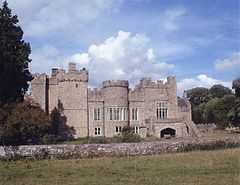Featherstone Castle
Coordinates: 54°56′35″N 2°30′36″W / 54.943°N 2.510°W
| Featherstone Castle | |
|---|---|
|
Featherstone Castle, 2005 | |
 Featherstone Castle | |
| OS grid reference | NY674610 |
| |
Featherstone Castle, a Grade I listed building, is a large Gothic style country mansion situated on the bank of the River South Tyne about 3 miles (5 km) southwest of the town of Haltwhistle in Northumberland, England.
Medieval origins
In the 11th century the manor house on this site belonged to the Featherstonehaugh family. It has played an important role in the battles between the English and the Scots. Originally a 13th-century hall house, a square three-storey pele tower was added in 1330 by Thomas de Featherstonehaugh. A survey from the year 1541 reported the property to be a tower in good repair, occupied by Thomas Featherstonehaugh.
The earliest recorded history of this area derives from the Roman occupation period; in 122 AD, the Romans erected Hadrian's Wall, the course of which lies about 5 kilometres to the north of Featherstone Castle.
Post medieval
In the 17th century the property was acquired by Sir William Howard (father of the 1st Earl of Carlisle) and was remodelled and substantially enlarged.

The house was repurchased from the Earl of Carlisle in 1711 by Matthew Featherstonehaugh (1662–1762). A survey of 1715 disclosed 'an ancient and well-built structure'. The family remained in occupation until Sir Matthew Fetherstonhaugh sold the property to James Wallace about 1789. His son Thomas Wallace carried out further alterations between 1812 and 1830. Lord Wallace bequeathed the estate to his nephew Colonel James Hope (1807–1854), (son of the Earl of Hopetoun), who changed his name to Hope-Wallace.
The various alterations to the structure have resulted in a large castellated and complex country house, rectangular in form with a central courtyard and towers at each angle.
Modern usage
The property was sold in 1950 and became a boys' preparatory school, known as Hillbrow School, named after the house where it had originally been established near Rugby School in the Midlands. Hillbrow by then was settled at Overslade House, which had been damaged by a landmine in 1940. In 1961 the school moved to new premises at Ridley Hall, Northumberland, and Featherstone Castle was converted to a residential conference and activity centre for young people and students.
References
- English Heritage: Images of England. Photograph and detailed architectural description
- The Gatehouse Gazetteer Featherstone Castle
- Plantagenet Somerset Fry, The David & Charles Book of Castles, David & Charles, 1980. ISBN 0-7153-7976-3
- A History of Northumberland (1840) John Hodgson Pt2 Vol3 pp353–8
- C. Michael Hogan (2007) Hadrian's Wall, ed. A. Burnham, The Megalithic Portal
- Stephen Johnson (2004) Hadrian's Wall, Sterling Publishing Company, Inc, 128 pages, ISBN 0-7134-8840-9
- Structures of the North East
- Images of Featherstone castle
External links
| Wikimedia Commons has media related to Featherstone Castle. |
